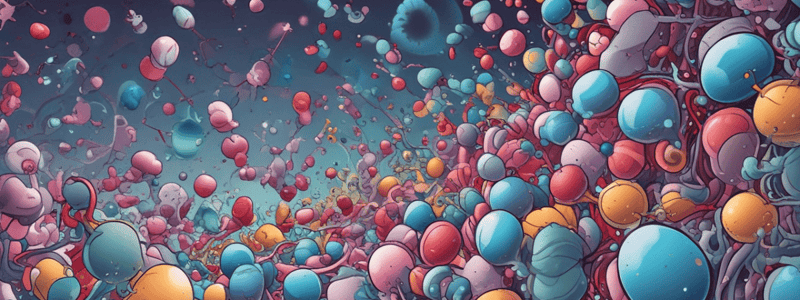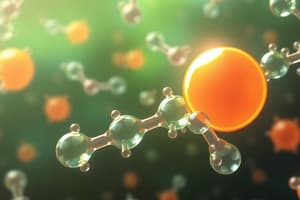Podcast
Questions and Answers
What is the primary mechanism by which beta-lactamases confer antibiotic resistance?
What is the primary mechanism by which beta-lactamases confer antibiotic resistance?
- They transport the antibiotic out of the cell.
- They increase the number of alcohol groups in the bacterial cell.
- They alter the membrane transport proteins.
- They hydrolyze the beta-lactam ring of the antibiotic. (correct)
How do beta-lactam antibiotics directly affect bacterial cells?
How do beta-lactam antibiotics directly affect bacterial cells?
- They interfere with the synthesis of the peptidoglycan layer. (correct)
- They disrupt bacterial RNA synthesis.
- They impair protein folding processes.
- They inhibit DNA replication.
Which proteins in bacterial cell walls do beta-lactam antibiotics primarily target?
Which proteins in bacterial cell walls do beta-lactam antibiotics primarily target?
- Membrane transport proteins
- Ribosomal proteins
- Penicillin-binding proteins (PBPs) (correct)
- Flagellar proteins
What role do penicillin-binding proteins (PBPs) play in bacterial cells?
What role do penicillin-binding proteins (PBPs) play in bacterial cells?
Which component of bacterial cells is directly affected by beta-lactam antibiotics causing cell death?
Which component of bacterial cells is directly affected by beta-lactam antibiotics causing cell death?
What is one purpose of the peptidoglycan layer in bacterial cells?
What is one purpose of the peptidoglycan layer in bacterial cells?
Flashcards are hidden until you start studying
Study Notes
Beta-Lactam Antibiotics
- Beta-lactam antibiotics are the most commonly used group of antibiotics globally due to their efficacy and tolerability.
- They are effective in combating antibiotic resistance, a growing concern worldwide.
Mechanisms of Antibiotic Resistance
- One common resistance mechanism involves the development of beta-lactamases that hydrolyze the beta-lactam ring, rendering the antibiotic ineffective.
- Other resistance mechanisms include:
- Membrane transport proteins
- Variants of penicillin-binding proteins (PBPs)
- Increased alcohol groups in some bacteria
Mode of Action of Beta-Lactam Antibiotics
- Beta-lactams inhibit bacterial growth by impeding the synthesis of the peptidoglycan layer in the cell wall.
- This disruption of the cell wall structure makes bacteria susceptible to lysis and death.
Peptidoglycans and Penicillin-Binding Proteins
- Peptidoglycans are long, repeating polymer cross-linking networks of sugar molecules.
- Penicillin-binding proteins (PBPs) in the bacterial cell wall facilitate the cross-linked construction of peptidoglycans.
- Beta-lactams mask the active site involved in peptidoglycan cross-links, leading to inefficient cross-links and ultimately, bacterial lysis and cell rupturing.
Studying That Suits You
Use AI to generate personalized quizzes and flashcards to suit your learning preferences.



